
This research is part of New_ Public, an initiative to advance the idea of public-friendly digital design. Just as urban designers figured out strategies for creating public spaces where people could co-exist harmoniously, New_ Public looks to identify strategies to create a thriving public digital space. This report, generously supported by The John S. and James L. Knight Foundation, Omidyar Network and Robert Wood Johnson Foundation, is a follow-up to our comprehensive Civic Signals report released in January 2021, which outlined 14 signals to guide the creation of healthy public digital spaces.
SUMMARY
The COVID-19 pandemic upended many people’s day-to-day lives, and moved more interactions online. In this report, we analyze how the pandemic affected people’s use of search, social, and messaging platforms as well as their thoughts about the platforms.
To do this, the Center for Media Engagement conducted a survey of 3,368 participants across five countries (Brazil, Germany, Malaysia, South Africa, and the United States) in July 2020. We asked participants about how COVID-19 changed their use of social media, search engines, and messaging apps, as well as about their rewarding and disappointing online experiences during the pandemic. These same respondents had answered an earlier survey, allowing us to analyze whether their responses to some questions changed over time.
CHANGING PRIORITIES DURING COVID-19
In most cases, public thoughts about what search, social, and messaging platforms should do were the same before and during the pandemic. In some cases, however, there were notable shifts. For some platforms, we found that:
- During the pandemic, more superusers (those using particular search, social, and messaging platforms more than others) wanted platforms to help communities recover after a crisis and to help people become informed citizens than before the pandemic.
- Fewer superusers thought it was important for platforms to help different groups interact, to keep people’s information secure, and to give citizens the opportunity to get involved in addressing society’s problems.
PLATFORM SIGNAL PERFORMANCE
In no instance did a majority of superusers of six popular platforms (Facebook, Facebook Messenger, Google, Instagram, WhatsApp, YouTube) believe that a platform performed well with respect to the 14 signals.
- Facebook, Facebook Messenger, Instagram, and WhatsApp superusers gave the platforms their highest scores on feeling connected to other people and groups. YouTube and Google superusers gave the platforms their highest scores on being able to get information on issues of concern.
- The highest percentage was 48% of WhatsApp superusers reporting that they felt connected to other people and groups on the messaging app.
- Several platforms received lower evaluations for making people feel like they could get help recovering from a crisis in their community and for making people feel like others treat them humanely on the platform.
- The lowest percentage was 6% of Facebook Messenger superusers who believed that they could get help recovering from a crisis in their communities on the messaging app.
USES OF SOCIAL MEDIA, MESSAGING, & SEARCH PLATFORMS DURING COVID-19
People reported that they increased the number of platforms that they used and spent more time on social media as a result of the pandemic. When we asked respondents how their tech use changed during the COVID-19 pandemic, they said they used social media, messaging apps, and search engines to:
- Connect with friends, family, and community members
- Read and share information and news about COVID-19
- Seek out forms of entertainment, new skills, and hobbies
- Shop online and check modified in-person store hours • Find meaning through uplifting stories
CONCERNS ABOUT SOCIAL MEDIA, MESSAGING & SEARCH ENGINES
When we asked respondents to describe their disappointing digital experiences during the pandemic, they expressed concerns about:
- The prevalence of false information and conspiracy theories online
- Censorship on the basis of ideology
- Digital arguments
IMPLICATIONS FOR PLATFORMS
Based on this research, platforms should consider:
- Highlighting actionable ways that individuals can help people in their communities
- Curating content that allows users to learn new skills and hobbies
- Taking a proactive approach to labeling false information, prioritizing information from reputable sources, and providing in-depth explanations of fact-checking and moderation policies
- Continuing to promote opportunities for people to meaningfully connect
INTRODUCTION
From the first confirmed case of COVID-19 on December 31, 2019 in Wuhan, China, the international effort to curb the spread of the coronavirus caused many workplaces to operate remotely, individuals and families to shelter in place, and social gatherings to happen virtually rather than in person. As people’s lives moved online like never before, we wanted to know how COVID-19 affected people’s use of social media, messaging apps, and search engines.
In December of 2019, the Center for Media Engagement worked with New_ Public and YouGov to field a survey across 20 countries to assess what people thought about platforms. In July of 2020, we re-contacted 3,368 of the original participants across five countries (Brazil, Germany, Malaysia, South Africa, and the United States). We asked them how COVID-19 affected their use of social media, search engines, and messaging apps, as well as about their rewarding and disappointing online experiences during the pandemic.
We centered this work around 14 signals, or properties of thriving digital spaces, that we uncovered in our earlier research.
WHAT WE FOUND
HOW THE PANDEMIC CHANGED USERS’ EXPECTATIONS
We compared what respondents expected of platforms in July of 2020 to what they said in December of 2019. In 2020, we asked people to evaluate whether each of the 14 signals were important for platforms to do during the coronavirus pandemic. We conducted this analysis for the most popularly used platforms: Facebook, Facebook Messenger, Google, Instagram, WhatsApp and YouTube. The analysis is among each platform’s “superusers,” or those using a particular search, social, or messaging platform more than others.
In most cases, superuser expectations did not change. Yet there were several notable exceptions.
More Google, Instagram, WhatsApp, and YouTube superusers thought that it was important for platforms to help communities recover from crises after the onset of the pandemic than they did before. Before coronavirus, between 14% and 18% of superusers across these platforms endorsed the idea. Amidst the pandemic, these percentages increased to between 18% and 26% of superusers.
Other ideas also were endorsed by higher percentages of platform users. For example, 32% of Facebook superusers, 22% of WhatsApp superusers, and 12% of Facebook Messenger superusers thought that it was important that these platforms help people become informed citizens before the pandemic. During the pandemic, Facebook and WhatsApp users saw 3% increases in the percentage of superusers saying that this was important. Facebook Messenger superusers saw a 13% increase.
Superusers also rated some signals as less important than they had before the start of the pandemic. Fewer Facebook, Google and WhatsApp superusers thought it was important to keep people’s information secure. Before the pandemic, between 46% and 49% of these platforms’ superusers thought that it was important. When asked if it was important during the pandemic, these percentages declined to between 36% and 38%.
Fewer superusers said that it was important that Facebook and WhatsApp provide opportunities for different groups to interact. Thirty-seven percent of Facebook superusers endorsed the idea prior to the pandemic compared to 31% during, and WhatsApp superusers declined from 35% to 30%.
The coronavirus pandemic heightened some people’s desire for the platforms to provide valuable and relevant information and dampened other priorities, such as signals related to data security and connections to different groups.
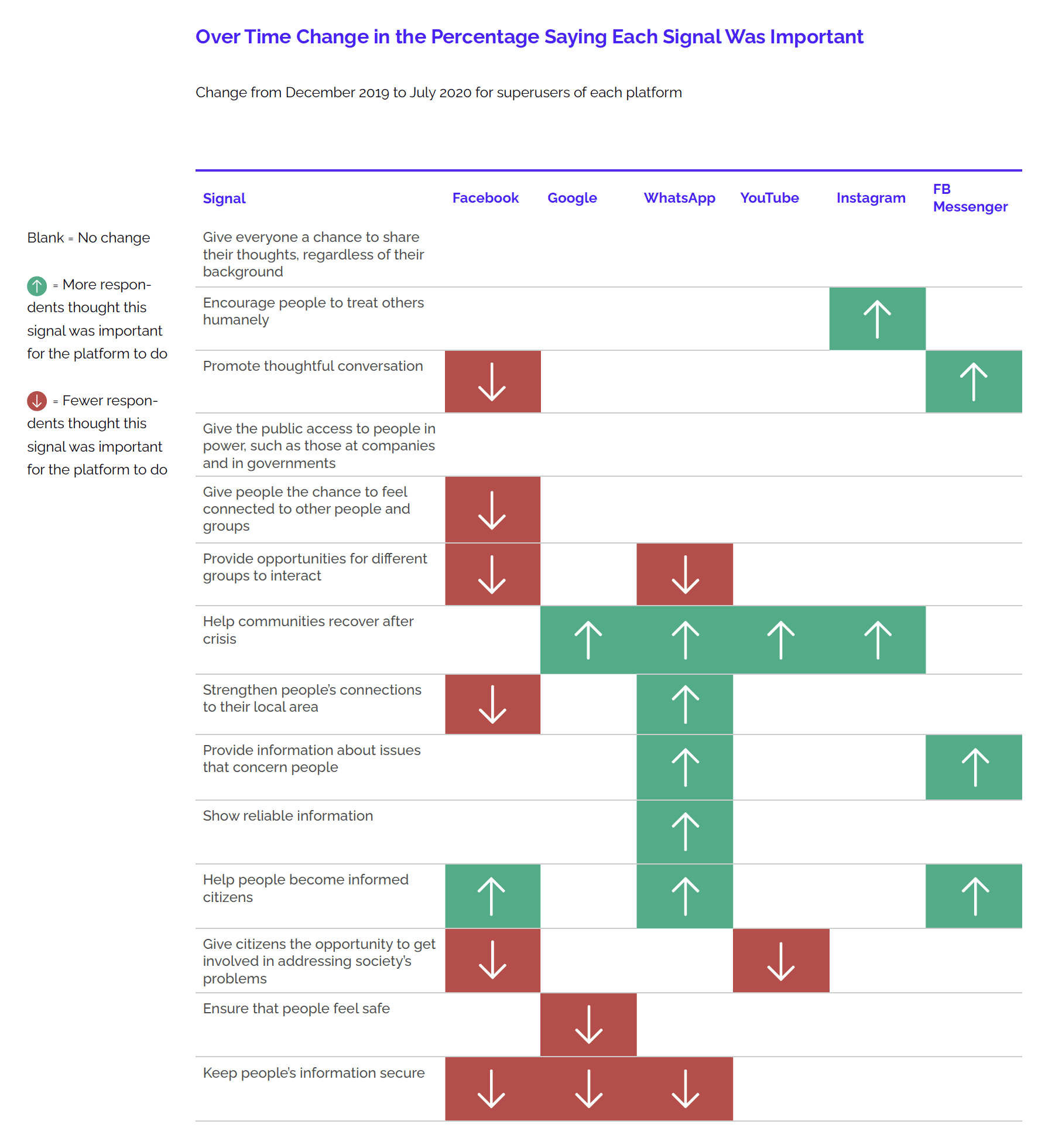
PLATFORM EVALUATIONS
We asked superusers to indicate whether they thought that the platforms were performing well with respect to the 14 signals.

We asked superusers to indicate whether they thought that the platforms were performing well with respect to the 14 signals.
In no instance did a majority of superusers believe that a platform was performing well with respect to the signals. The highest percentage was 48% of WhatsApp superusers reporting that they felt connected to other people and groups on the messaging app. The lowest percentage was 6% of Facebook Messenger superusers who believed that they could get help recovering from a crisis in their communities on the messaging app.
Google performed best on signals related to information. Higher percentages of the search engine’s superusers thought that Google allowed them to get information about issues that concerned them (43%), to get reliable information (43%), and to become a more informed citizen (38%) compared to the other signals. Fewer superusers thought that others treated them humanely (12%), that they could have thoughtful conversations (14%), or that they could access people in power (14%) on the platform.
Facebook performed best on connecting others, with 41% of Facebook superusers stating that they felt connected to other people and groups on the platform. It also performed an expressive function for 31% who said that they felt able to share their thoughts. The platform received lower scores on signals such as superusers feeling like they could get help recovering from a crisis in their community (14%), feeling like others treat them humanely (15%), and believing that their information is secure (15%).
Over four in ten Instagram superusers thought that the platform allowed them to feel connected to other people and groups (43%). Around a third of superusers thought that Instagram allowed them to interact with people who were unlike them (36%) and to have thoughtful conversations (32%). Few superusers felt that they could get help recovering from a crisis in their community (15%) or get involved in addressing society’s problems (18%) on Instagram. And only 18% thought that their information was secure on the platform.
The highest percentages among YouTube superusers were 42% that believed that they could get information about issues that concerned them and 35% that believed that they could become a more informed citizen on the platform. Only 10% felt like others treated them humanely on the platform, 11% thought that they could access people in power, and 12% thought that they could have thoughtful conversations or get help recovering from a crisis via YouTube.
For WhatsApp, nearly five in 10 superusers felt connected to other people and groups via the messaging app (48%). Thirty-eight percent thought that they could have thoughtful conversations on the platform and 35% felt able to share their thoughts. WhatsApp received its lowest ratings on accessing people in power: only 15% believed that they could do so on the platform. Nineteen percent believed that others treated them humanely on WhatsApp, that they could get help recovering from a crisis in their community, and that they could get involved in addressing society’s problems on the platform.
Among Facebook Messenger superusers, 36% felt connected to other people and groups and 28% thought that they could have thoughtful conversations on the app. In contrast, only 6% thought that they could get help recovering from a crisis, 7% thought that they could access people in power, and 9% thought that they could get reliable information from the messaging app.
MORE TIME ON SOCIAL MEDIA
Respondents described spending more time on social media as a result of the COVID-19 pandemic. They also used a higher number of social media platforms. More people reported recently using Facebook, Twitter, Instagram, LinkedIn, Reddit, Pinterest, and YouTube when surveyed during the pandemic than before the pandemic. The increases ranged from a low of 0.8% more people using Reddit to a high of 7.7% more people using YouTube. Of all the social media platforms we studied, only Snapchat did not see an increase in usage during the pandemic.
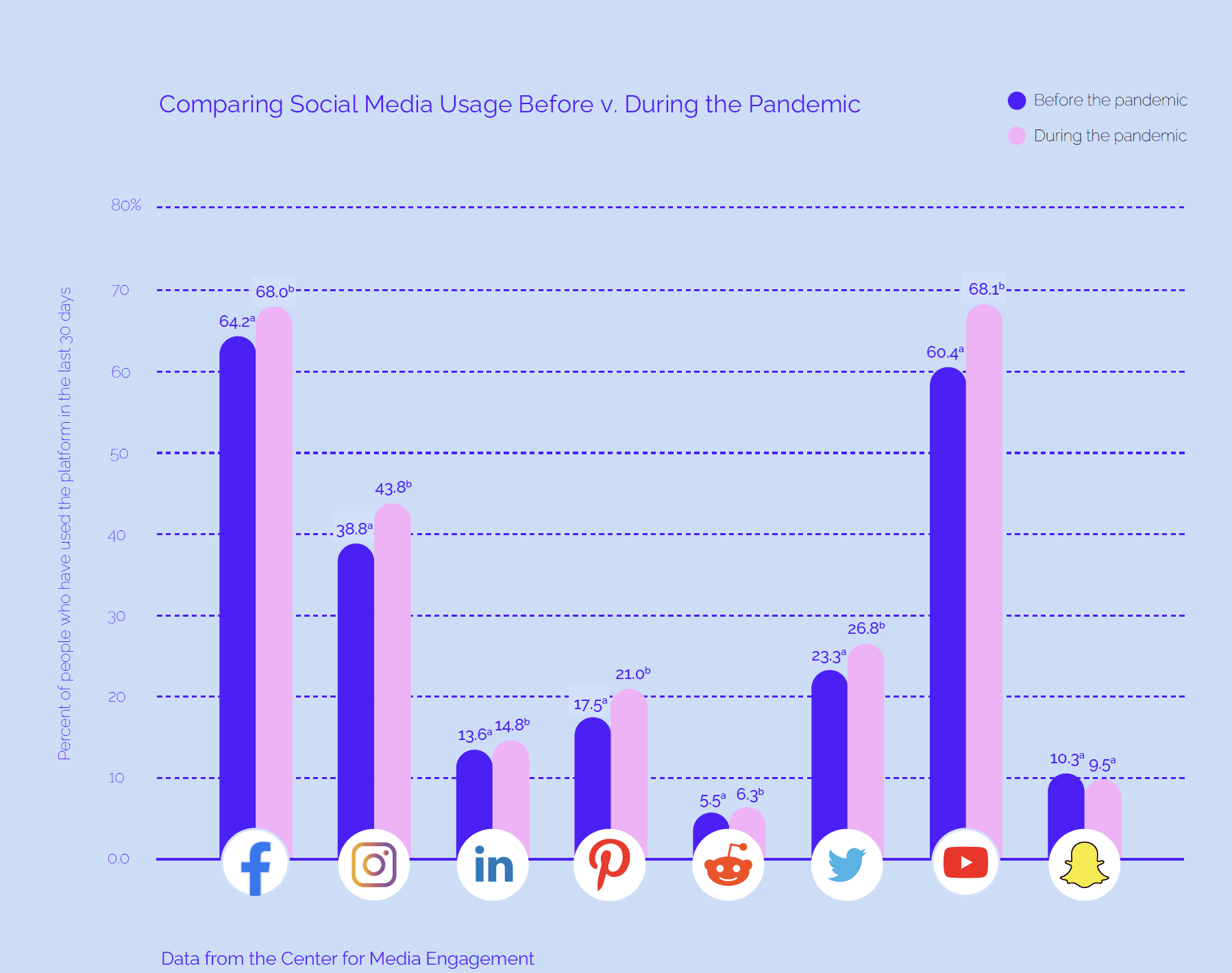
The increase in social media usage was the most notable in the United States and the least pronounced in Brazil. Although all social media platforms except Snapchat saw a rise in recent usage in the United States, Instagram was the only social media platform Brazilians said they used more during the pandemic than before. Respondents in Malaysia, South Africa, and Germany fell somewhere in between, with an increase in recent usage of five of the eight social media platforms among Malaysians, four of the eight among South Africans, and two of the eight among Germans.
Many explained that the increase was due to more time spent at home. “I’m much more active on most platforms. Spending roughly 2+ hours a day on social media. I have more free time because I’m not commuting to work and social media can be relaxing,” explained a South African social media user.
Similarly, other respondents noted that they turned to social media as a replacement for the activities they used to enjoy prior to the pandemic. For example, a survey participant from the United States said, “I am spending more and too much time on social media since I can no longer do so many of the other things like travel, eating in restaurants, getting together with groups of friends, that I used to enjoy.”
Most messaging apps and search engines also saw an uptick in recent usage. Only respondents’ recent usage of Yahoo’s search engine remained unchanged.
That being said, when asked in an open-ended question about changes to their social media, messaging, and/or search engine habits, many respondents also indicated that there had been no changes. Some simply stated “no change” and others provided insight into their experiences. One respondent from Germany wrote, “No changes in usage since I only use any media sporadically, don’t follow any courses there, only contact people I know.”
CONNECTING WITH FRIENDS & FAMILY
In a time of social distancing, respondents believed that social media and messaging apps could act as vehicles for connecting with friends and family. A social media user from the United States said, “I now use social media as a form of wellness checking on associates, family, members and friends.” Respondents felt similarly about messaging apps. For example, a participant from Malaysia shared, “During the covid 19 pandemic, messaging was the most important way to keep contact with your family or loved ones that you could not travel to see.” Some even expressed that they felt closer to friends and family than before the pandemic, like a respondent from Germany who said, “The bond with close friends and family has improved via online.”
Many indicated that they engaged in virtual communication due to the lack of in-person contact. A Brazilian social media user said: “Due to social isolation, access to social networks has increased considerably because I find it a great way to interact and this makes me feel not alone!” A respondent from South Africa utilized messaging apps in a similar way, stating “Because we are not allowed to visit anyone at the moment, I have made a lot more use of my messaging apps…we still feel connected through ‘speaking’ to each other and finding out how the other person is feeling, coping and finding out about their future plans.”
For others, the rewarding experience was the ability to participate virtually in their friends’ and family members’ important life events. “My 5th Granddaughter was borne, seeing her on Facebook is wonderful,” shared a social media user from the United States. A respondent from Brazil wrote, “I have been using social media to talk to friends and relatives. I have participated in weddings and welcome events.”
Although many used social media and messaging apps to nurture existing relationships, a few respondents made new friends online. One respondent from the United States reported, “I have made many Facebook friends during this pandemic who give me hope for humanity. They have become as close or even closer than real life friends in their support and caring. I value Facebook due to these friendships.”
COVID INFORMATION
With the evolving nature of the pandemic, respondents used social media, messaging apps, and search engines to seek out and share information about COVID-19.
Survey respondents stressed the importance of staying informed about the state of COVID cases and deaths, oftentimes highlighting the need for frequent updates. A social media user from Brazil explained, “I am seeking more information from government agencies to be up-to-date on what is being done to minimize the impact of the pandemic on my city and region.” Likewise, respondents used messaging apps to share information about COVID-19. One messaging app user from South Africa shared, “We are no longer having normal conversations, we speak daily about Coronavirus.”
Others used messaging apps and social media to share information about the prevention of COVID-19. A messaging app user in Malaysia experienced “more friends and relatives sharing endless news and tips on virus fighting!” Comparably, a German social media user “share[d] information on how to deal with the corona pandemic; to support hygiene measures, for example.”
Search engines helped respondents find COVID-19 updates. A respondent from South Africa conducted “A lot more searches for info on the virus and world news to stay up to date and a lot of searching for items like sanitizers etc to feel more safe.” A search engine user from Germany explained the need to stay informed, stating, “During this time, I’ve dealt with health issues significantly more often. Since I belong to the risk group due to my age, it’s important to me to be informed of all health problems.”
When asked specifically to share rewarding experiences that they’ve had online, survey respondents highlighted the ability to access information about COVID-19. For example, a respondent from the United States wrote, “Just being able to keep up with all the rapidly developing events of this pandemic is a rewarding social experience.” Others appreciated receiving information from experts, such as a respondent from Malaysia who valued “Messages from doctors who are safe and from trusted sources.”
ENTERTAINMENT, NEW SKILLS & HOBBIES
Respondents turned to social media and search engines to find entertainment. In many cases, they explained that entertainment helped to distract them from boredom or stressful situations. For example, a respondent from Malaysia “used [social media] more frequently. To kill boredom, to learn new knowledge.” A respondent from the United States explained that “seeing animal pictures” was a rewarding experience, elaborating by stating, “Seriously. I get tired of all the drama and it’s nice to have a little something to make me smile.”
Respondents also reported using social media and search engines to find at-home activities. A German social media user “Used [social media] a lot more, mainly for sports and yoga videos, information on corona, and cooking or baking recipes.” On the same note, a search engine user from the United States said, “I search for gardening ideas” and a respondent from Malaysia wrote, “I search many of recipe, during mco [movement control order].”
Others used search engines to learn new skills. A search engine user from Brazil wrote, “I started researching more free courses, as well as various subjects that I found interesting and studied.” Similarly, a respondent from South Africa shared that they “search for new skills to learn to keep busy while staying indoors.”
MISINFORMATION & CONSPIRACY THEORIES
Respondents expressed dissatisfaction with misinformation and conspiracy theories on social media, messaging applications, and search engines. For some, these concerns led them to use platforms less. “During the pandemic I learned not to trust all the information seen across social networks,” explained a social media user from Brazil. A user of messaging apps from Malaysia similarly felt “overwhelmed with fake and unreal stories and forward[ed] materials without credibilities.”
Some were concerned about finding false information particularly on search engines. A respondent from South Africa shared this fear, stating, “There is a lot of information that is available on search engines since the pandemic and there are sites that offer false information giving fake news and there are sites that are opportunistic trying to get valuable information especially through email. I therefore make sure that whenever I am on the search engine I go for sites that I am familiar with to avoid being hacked or being fed fake information.”
On the other hand, some used search engines as a tool to verify whether information they saw elsewhere was truthful. “I use it to search for news and check whether the facts reported on social networks are true,” wrote a search engine user from Brazil.
The misinformation problem led users of all platforms — social media, messaging apps, and search engines — to approach information with more skepticism. A social media user from Germany answered that “people have become more cautious because of fake news and don’t believe everything that’s written.” A respondent from Brazil wrote about “being very careful, because in apps like WhatsApp there is more false information rolling around.”
Some had increased anxiety about accidentally sharing misinformation. “I became more thoughtful of what I shared or retweeted. Any conspiracy theories or untested remedies related to Covid-19 I stayed away from. I did not even want to interact in the event I inadvertently share these with my followers or other Twitter users,” said a social media user from South Africa.
CENSORSHIP
Censorship was a concern for some respondents who felt their opinions were being restricted by platforms based on ideology. A respondent from the United States said, “I don’t search for information on Covid19 using Google or other platforms because they are full of fake news and have an agenda I don’t agree with. I receive my information from…[news] briefings from the President, Vice President and task force.”
Others felt that restrictions were too stringent in different ways. A social media user from Malaysia shared, “During a twitter broadcast, my admonishment of a bunch of accounts denouncing vaccines was the one gotten my comment privilege revoked throughout…The comment section should have been moderated by a human being who can understand context, not an algorithm alone.” Another social media user from Germany expressed a similar opinion, sharing a disappointing experience with the “restriction of opinion” and stating a belief that “sarcasm isn’t recognized and thus deleted.”
In addition to the major themes shared thus far, there were several other less frequent, but still noteworthy, themes in people’s COVID-related digital experiences.
ONLINE & IN-PERSON SHOPPING
Respondents used search engines to double- check store hours due to changes as a result of COVID-19. Others decided to skip in-person stores and opt for online shopping for their necessities. “I began using search engines even more, searching for different kinds of products or food that we can get in my area or products that I really needed but do not wish to get them from the mall,” wrote a search engine user from Malaysia.
More generally, respondents reported shopping online more often than before the pandemic. A respondent from the United States provided insight into the benefits of online shopping, explaining, “I most certainly shop more online, than pre-Outbreak !… With all the closures & lockdowns, I’ve really had to increase my on-line searching and purchasing, and become more adept at figuring [out] sizes, and other particulars, when on-line…”
A respondent from Brazil used social media to sell products; “I started to interact more as to promote my handcrafts. I have the possibility of thousands of people seeing my crafted work.”
UPLIFTING STORIES
Respondents reported that their rewarding digital experiences during the pandemic included hearing uplifting stories about individuals who recovered from COVID-19 or examples of community members helping each other. A respondent from the United States wrote about a young man from church who was in the hospital due to COVID. “His Mom posts how he’s doing every day. He just had his trache removed over the weekend. Not sure how many people are following her posts but he has received numerous cards and gifts and also a phone call from the Governor,” the respondent wrote. Another example came from a German social media user who shared a rewarding experience of seeing “Posts on help from younger people to older people, shopping for them, etc.”
Others explained that they personally helped others in their community. A respondent from Brazil said, “We are forming support groups and helping each other with our most pressing issues.”
DIGITAL ARGUMENTS
In terms of disappointing experiences online, respondents mentioned arguments on social media. Subjects of arguments included politics, COVID-19, and racial injustice. A respondent from South Africa shared this experience on social media: “On facebook, I commented on a post where I knew misinformation was being pushed and when I corrected, I had a flood of negative comments directed at myself.” The user further explained, “Working on the Health sector, I’m informed of current information and it errs me when people don’t have facts and push their agendas be it political…or for self gain.”
Likewise, a social media user from the United States commented on a shift in tone, writing, “I made a couple of comments on different posts and have received really nasty and aggressive responses. The tone and aggression has really ramped up in the past several months.”
One German social media user, however, viewed the ability to argue as a benefit, writing, “I’ve shared information, argued, and generally interacted more with other people online, even with strangers. It offers the possibility of a ‘contactless’ exchange of ideas.”
METHODOLOGY
We fielded two surveys with YouGov in five countries: Brazil, Germany, Malaysia, South Africa, and the United States. The first survey was sent out in December 2019, before COVID-19 was declared a pandemic by the World Health Organization, and the second survey was fielded in July 2020 where respondents to the first survey were recontacted. In each survey, we asked respondents to select the social media platform, messaging app, and search engine they used most frequently in the last 30 days. We labeled respondents who chose the same social media platform, messaging app, or search engine as their most frequently used platform in both surveys superusers. The five countries were selected because we had previously conducted both focus groups and surveys in these countries. They were selected based on consulting with international social media experts. Further, the countries are geographically diverse with relatively high rates of 3G penetration, as well as Facebook, Twitter, YouTube, and internet usage. More about the process can be found in the Focus Group Methodology report here.
Our data include 1,535 respondents from Germany, 653 from the United States, 450 from Malaysia, 396 from South Africa, and 334 from Brazil. We have data for 1,421 Facebook superusers, 818 YouTube superusers, 374 Instagram superusers, 2,950 Google superusers, 433 Facebook Messenger superusers, and 2,193 WhatsApp superusers. Data were weighted based on age, gender, and in some countries also included some combination of education, region, social grade or social economic class, ethnicity or race, and city type. In both surveys, people were asked whether the 14 signals identified by our Civic Signals research were important for the platform to do. We tested for differences between responses before and during the pandemic using McNemar tests.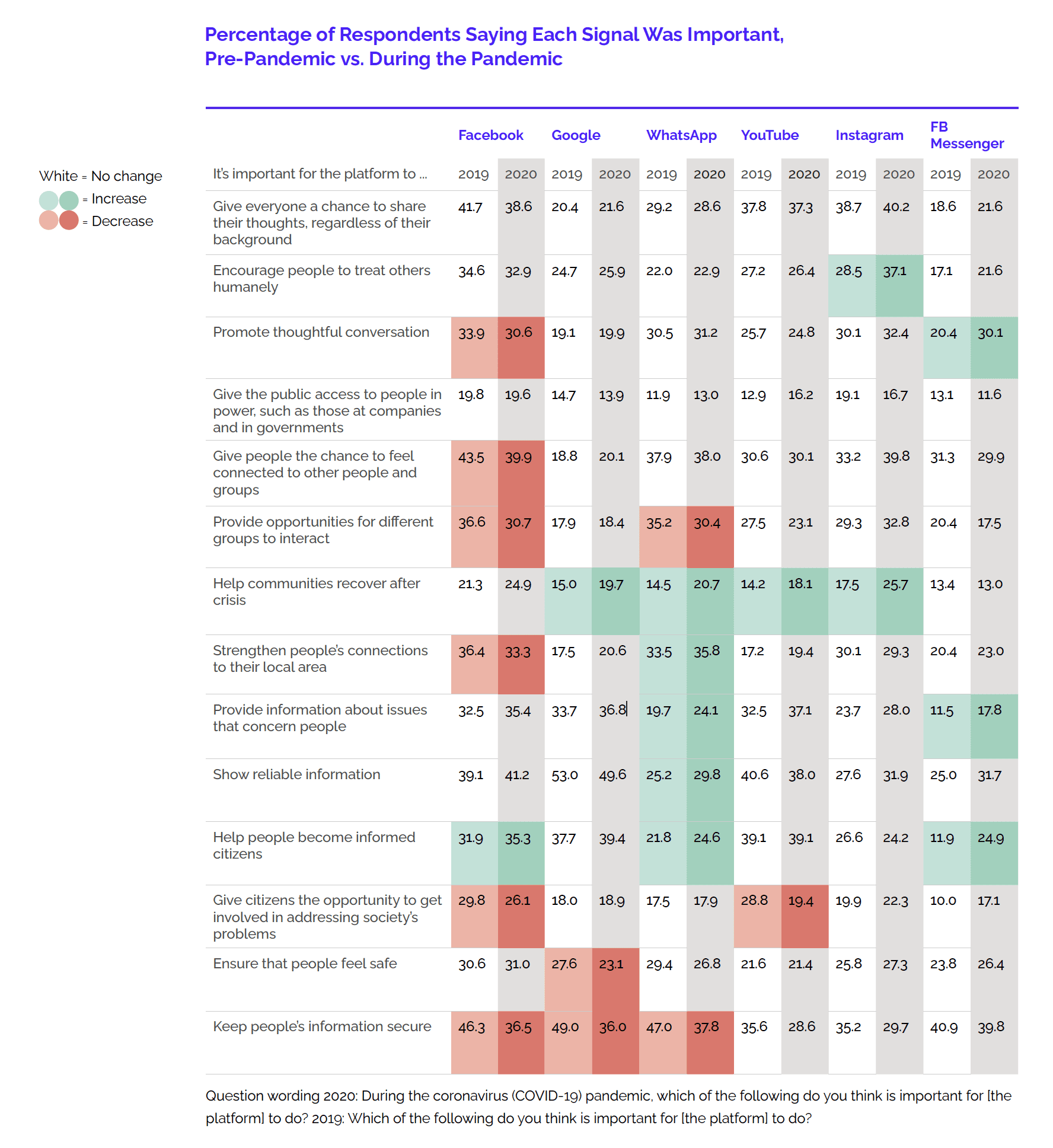
For all but the first and third signals, there was a significant difference between 2019 and 2020. We analyzed what demographic, political, and geographic factors predicted people changing their importance ratings using logistic regression. There were few consistent patterns, as summarized below.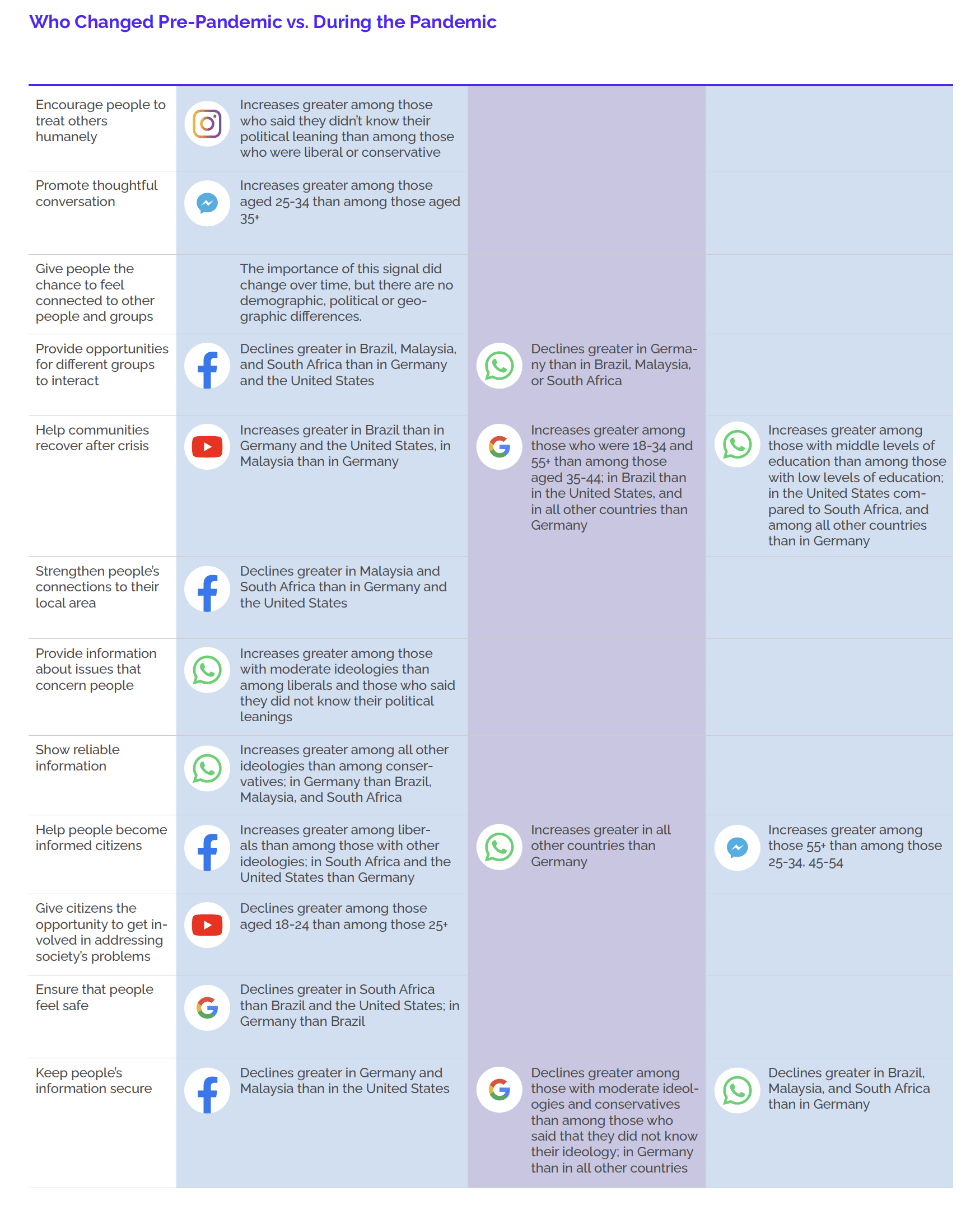
We then asked superusers to state their thoughts about the platform’s performance on the 14 signals. We analyzed whether people’s thoughts varied by their demographic, political, and geographic characteristics using logistic regression. The results are summarized in the tables below. The labels indicate which group was more likely to feel that the signal applied to their experiences on the platform. The label “other” indicates differences were present, but the pattern was not consistent. For ideology, we recorded “other” if those who identified as neither left- nor right-leaning differed from other respondents and there were no differences between liberal and conservative respondents. For education, we recorded “other” if those with middle levels of education differed from those with higher or lower levels of education, but there were no differences between those with high and low levels of education. For age, we recorded “other” if the pattern was something other than those who were older or those who were younger feeling that the signal applied to their experiences. For instance, if those who were middle-aged differed from those who were older and younger, we recorded “other.”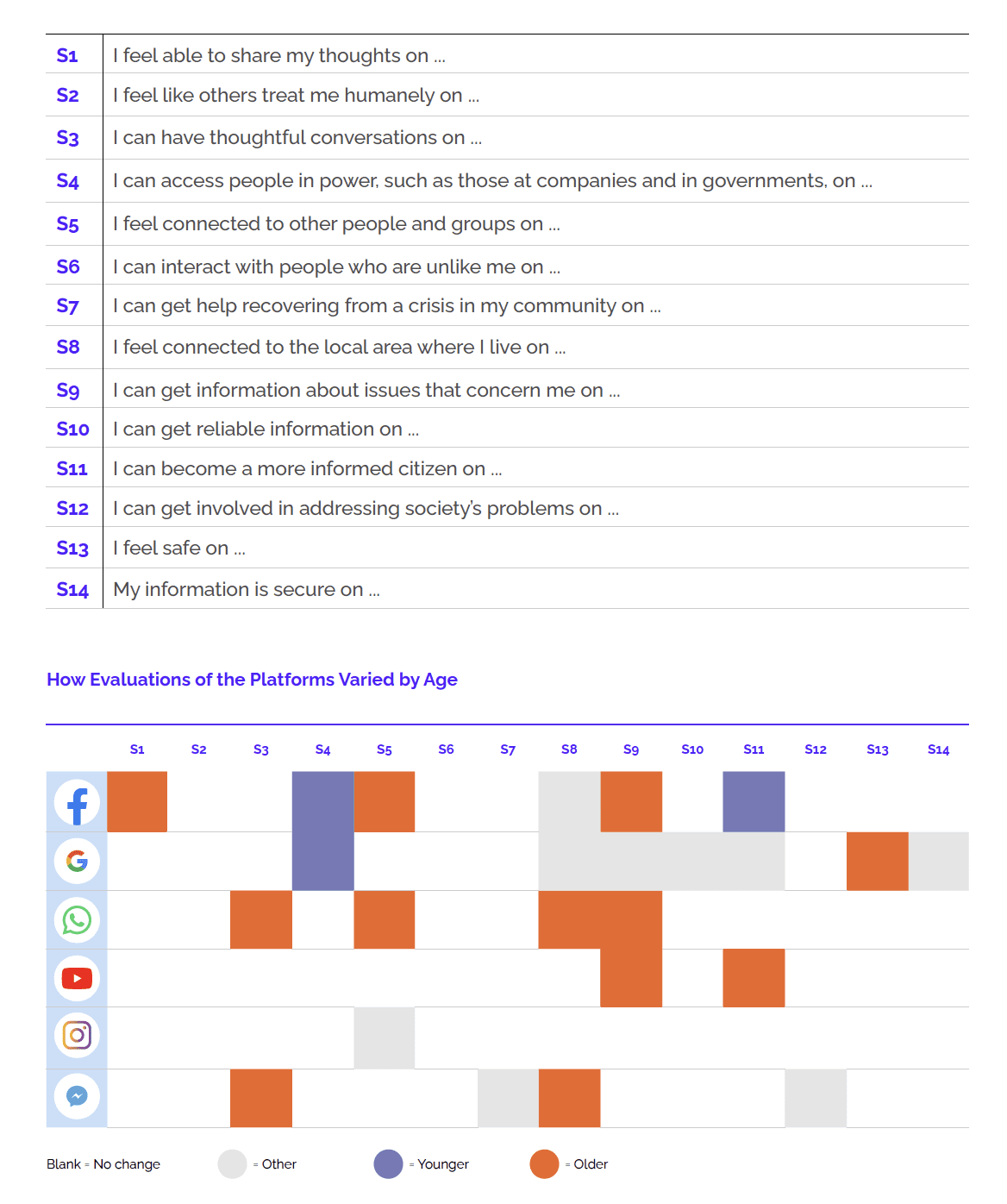
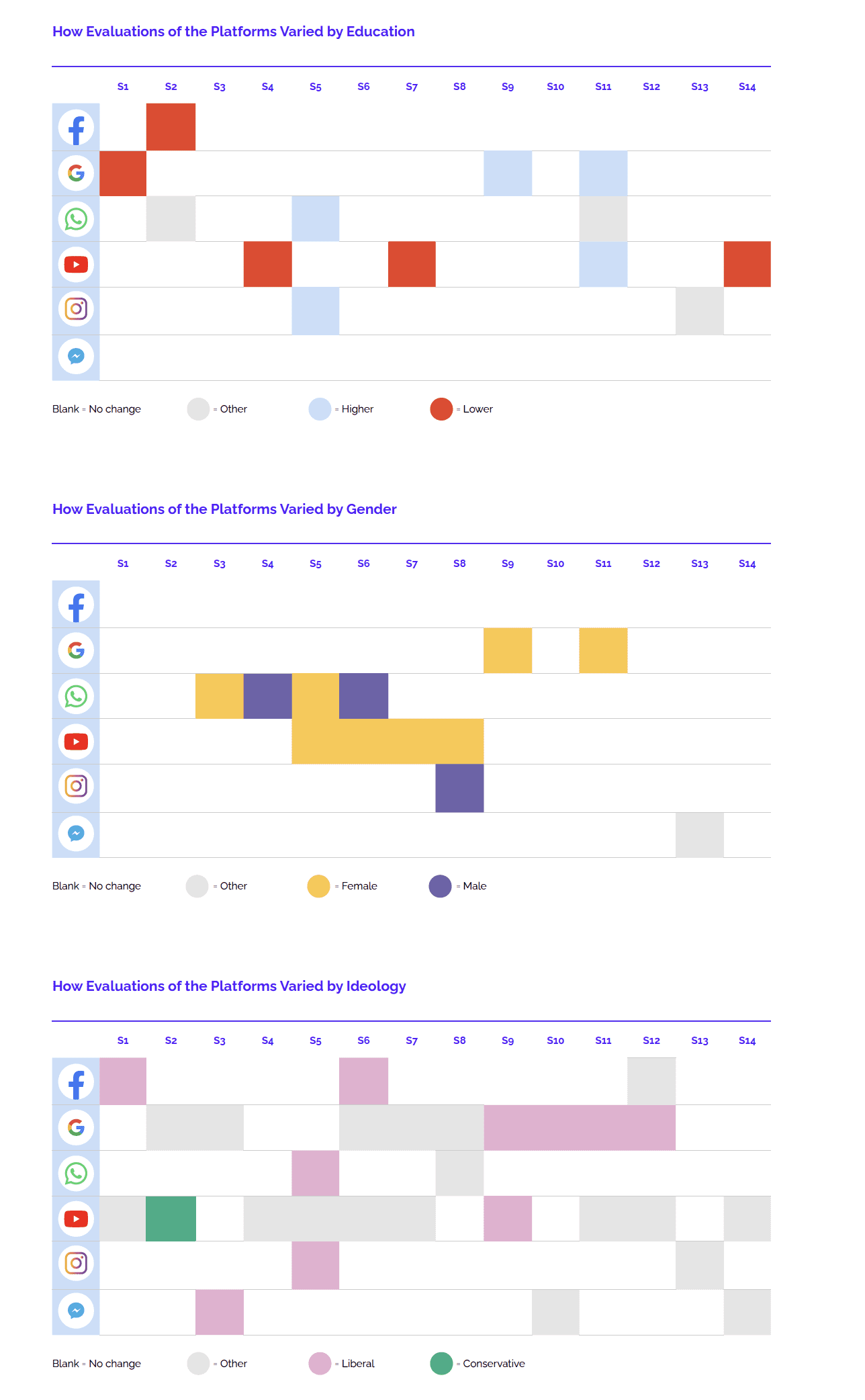
We also examined if there were differences among the five countries. In general, respondents from Germany and the United States were less likely than respondents from Brazil, Malaysia, and South Africa to say the signals represented their experiences on the platforms. The only exceptions were (1) Instagram superusers on feeling like others treat them humanely, where German respondents were least likely to agree, followed by Malaysians, Americans, South Africans, and Brazilians, (2) WhatsApp superusers on feeling safe and believing that their information is secure, where Germans were least likely to agree, followed by Brazilians, Malaysians, Americans, and South Africans, and (3) Facebook Messenger, where the patterns routinely differed likely because most superusers were from the United States.
The survey also included five open-ended questions that asked people to describe their online experiences. We asked, “During the coronavirus (COVID-19) pandemic, how have the ways that you use social media changed?”, then asked the same question again for messaging apps and search engines. We also asked, “Can you describe, in detail, a disappointing online social experience that you have had since the coronavirus (COVID-19) pandemic started?”, and “Can you describe, in detail, a rewarding online social experience that you have had since the coronavirus (COVID-19) pandemic started?”
To analyze the open-ended questions, we identified themes through an iterative process of reviewing survey responses. We first analyzed responses for each question, one country at a time. We then highlighted themes that appeared across multiple countries, then ranked the themes in terms of which appeared most frequently or was expressed most strongly. We reviewed responses several times to make sure that the named themes captured the sentiments that people expressed.
This work was generously supported by The John S. and James L. Knight Foundation, Omidyar Network and Robert Wood Johnson Foundation.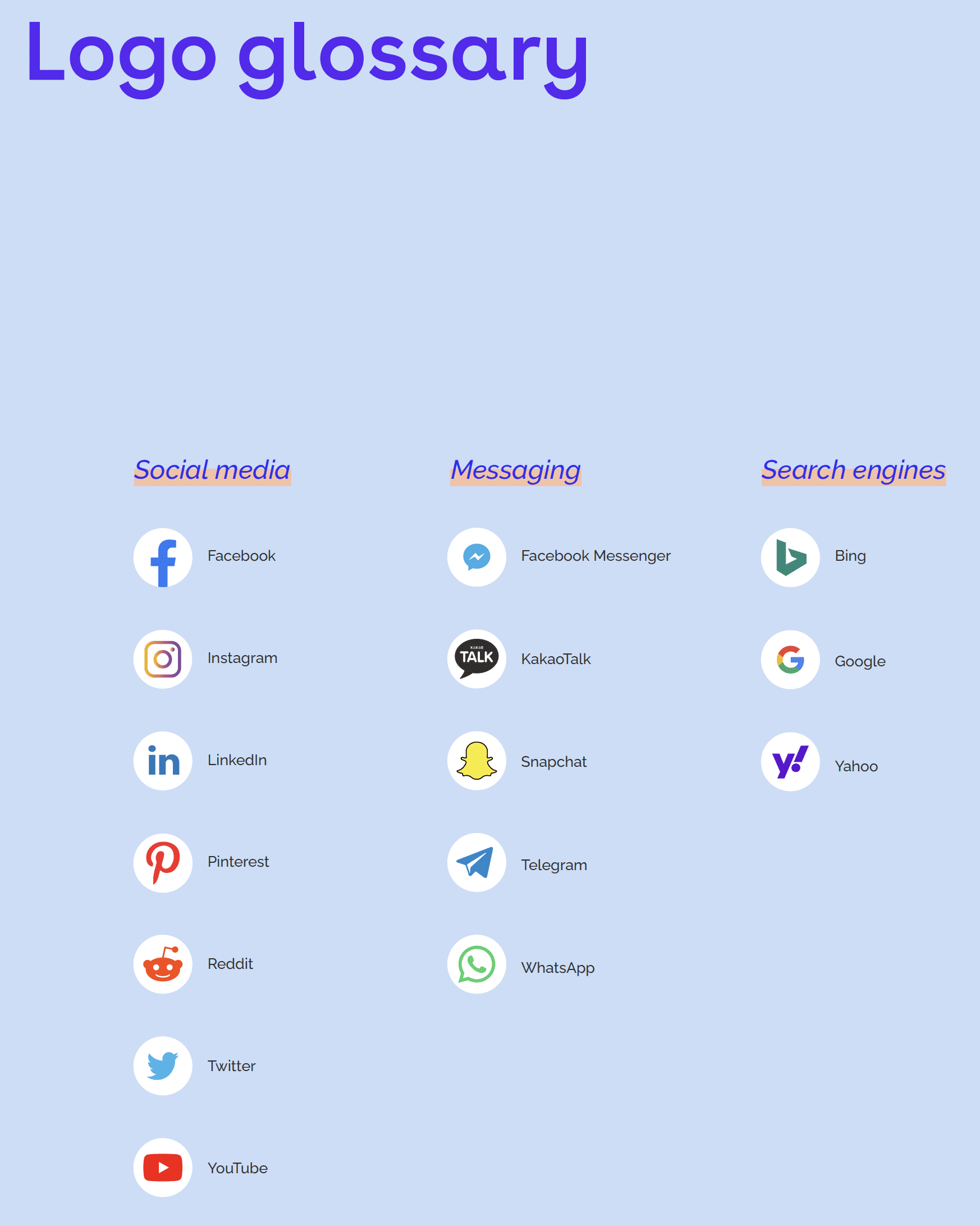
© 2021 New_ Public. This work is licensed under a Creative Commons Attribution-NonCommercial 4.0 International License. Credit must be given to both New_ Public and the author or authors of this report.



